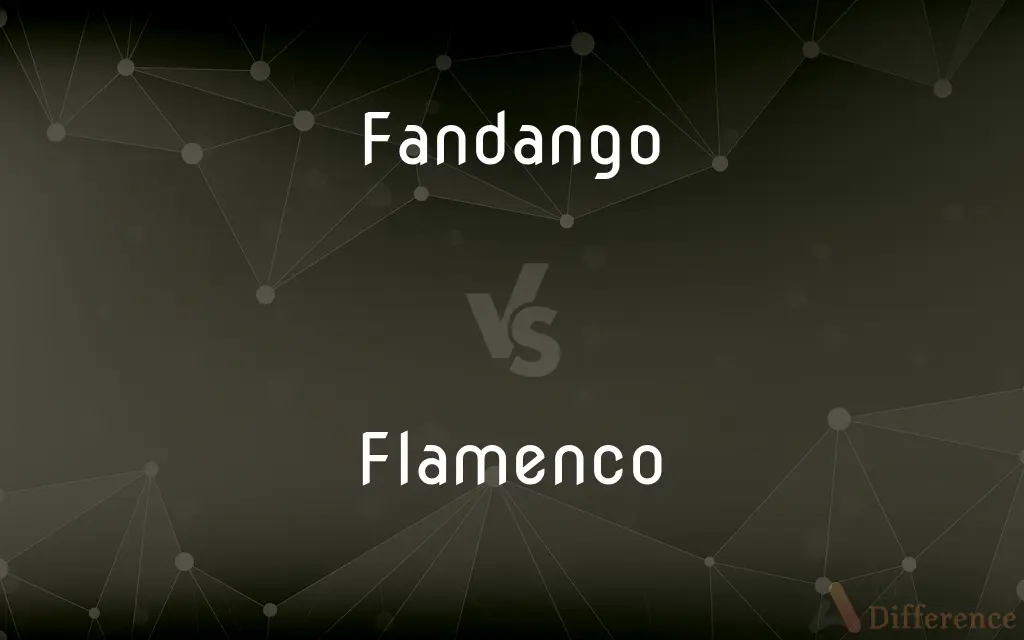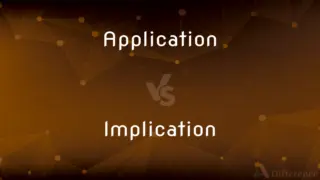Fandango vs. Flamenco — What's the Difference?
Edited by Tayyaba Rehman — By Fiza Rafique — Updated on May 3, 2024
Fandango is a lively Spanish dance performed in triple metre, accompanied by guitars and castanets, while Flamenco is highly expressive Spanish dance form characterized by its intense emotions, percussive footwork, and intricate hand and body movements.

Difference Between Fandango and Flamenco
Table of Contents
ADVERTISEMENT
Key Differences
Fandango is a traditional Spanish dance known for its lively tempo and courtship themes, typically played in duple time. Whereas, Flamenco is recognized for its emotional intensity and is often performed solo, focusing on personal expression and includes singing, guitar playing, and dance.
Fandango often emphasizes a cheerful atmosphere and involves both partners dancing playfully, while Flamenco can convey a range of emotions from sorrow to joy, with a strong emphasis on dramatic expressions.
Fandango uses traditional Spanish music with a steady rhythm, which is crucial for the dance sequence, whereas Flamenco music is characterized by its complex rhythms and often incorporates improvisation.
In terms of attire, Fandango dancers typically wear traditional Spanish clothes suitable for lively movements, whereas Flamenco attire is usually more dramatic and flamboyant, reflecting the emotional intensity of the performance.
Fandango is generally more structured and less varied in terms of musical and dance styles compared to Flamenco, which has a vast array of styles and interpretations, influenced by various historical and cultural factors.
ADVERTISEMENT
Comparison Chart
Origin
Spain, particularly from the 18th century
Southern Spain, with historical roots
Rhythm
Triple metre, steady tempo
Complex, often irregular rhythms
Emotional Expression
Typically cheerful and lively
Intense, varying from sorrow to joy
Performance
Partners dance together, structured
Often solo, highly expressive and improvisational
Attire
Traditional Spanish, functional for dance
Dramatic and flamboyant, reflecting emotional depth
Compare with Definitions
Fandango
A metaphor for a complex or elaborate act.
Organizing the event was a real fandango of logistics and scheduling.
Flamenco
A passionate or intense manner of doing something.
He approached each challenge with a flamenco-like intensity.
Fandango
Music specifically composed for the fandango dance.
The band played a fast-paced fandango that energized the crowd.
Flamenco
(Clothing) Specific style of dress associated with flamenco dancing.
She wore a striking flamenco dress with ruffles and a fitted bodice.
Fandango
(Informal) A foolish or useless act or thing.
The debate turned into a fandango of pointless arguments.
Flamenco
An art form involving cante (singing), baile (dance), and guitarra (guitar playing).
Flamenco is more than a dance; it’s a cultural expression steeped in history.
Fandango
A lively Spanish dance in triple metre.
They danced the fandango at the festival, heels clicking on the cobblestone.
Flamenco
Guitar music composed for flamenco.
His fingers flew over the strings in an impressive display of flamenco.
Fandango
A card game played in Spain similar to rummy.
They settled down to play a few rounds of fandango after dinner.
Flamenco
A genre of Spanish music, song, and dance from Andalusia.
She practiced her flamenco steps diligently, aspiring to capture its soulful essence.
Fandango
The music for this dance.
Flamenco
Flamenco (Spanish pronunciation: [flaˈmeŋko]), in its strictest sense, is an art form based on the various folkloric music traditions of southern Spain, originating in the culture and traditions of the Calé Roma, commonly known in Spanish as Gitanos, of the region of Andalusia, but also having a historical presence in Extremadura and Murcia. In a wider sense, the term is used to refer to a variety of Spanish and Roma musical styles.
Fandango
Fandango is a lively partner dance originating from Portugal and Spain, usually in triple meter, traditionally accompanied by guitars, castanets, or hand-clapping. Fandango can both be sung and danced.
Flamenco
A dance style of the Andalusian Romani people, characterized by forceful, often improvised rhythms.
Fandango
An animated dance in triple time of Spanish origin, popular on the Iberian Peninsula and in Latin America.
Flamenco
A dance in this style.
Fandango
(Informal) Nonsense; tomfoolery.
Flamenco
The guitar music that usually accompanies a dance in this style.
Fandango
A form of lively flamenco music and dance that has many regional variations (e.g. fandango de Huelva), some of which have their own names (e.g. malagueña, granadina).
Flamenco
(uncountable) A genre of folk music and dance native to Andalusia, in Spain.
Fandango
A gathering for dancing; a ball.
Flamenco
(countable) A song or dance performed in such a style.
Fandango
An unknown entity or contraption.
What’s that fandango you’re using?
Flamenco
(intransitive) To dance flamenco.
Fandango
A confusion; a chaotic collection.
Flamenco
A strongly rhythmic and vigorous style of dancing characteristic of the Andalusian gypsies, characterized by clapping and stamping of feet.
Fandango
An extravaganza; an instance of lavish and fantastical events or behavior.
Flamenco
A strongly rhythmic style of music originating in southern Spain, often improvisatorial, performed by itself, often on a guitar, or as an accompaniment to flamenco dancing.
Fandango
(color) A shade of red-violet. en
Flamenco
Guitar music composed for dancing the flamenco
Fandango
(dance) To dance the fandango.
Flamenco
A style of dancing characteristic of the Andalusian gypsies; vigorous and rhythmic with clapping and stamping of feet
Fandango
(figuratively) To dance, particularly with a lot of energy.
Fandango
A lively dance, in 3-8 or 6-8 time, much practiced in Spain and Spanish America. Also, the tune to which it is danced.
Fandango
A ball or general dance, as in Mexico.
Fandango
A provocative Spanish courtship dance in triple time; performed by a man and a woman playing castanets
Common Curiosities
What is the basic rhythm of the fandango?
The basic rhythm of fandango is in triple metre, usually lively and brisk.
Can flamenco be performed as a group?
While typically centered on solo performances, flamenco can also be performed by groups, especially in forms like "fiesta flamenca".
Is singing a part of fandango performances?
Singing can be part of fandango but it is primarily focused on the instrumental and dance aspects.
Are there different styles within the flamenco genre?
Yes, flamenco has several styles or "palos", ranging from deeply emotional to light and festive.
What instruments are commonly used in fandango music?
Guitars and castanets are commonly used in fandango music.
Are there competitive events for flamenco dancers?
Yes, there are competitions for flamenco dancers, which are opportunities to showcase skill and innovation within the art form.
How does flamenco express emotion?
Flamenco expresses deep emotions through intense vocal performance, dramatic dance movements, and expressive guitar play.
What type of attire is worn by flamenco dancers?
Flamenco dancers wear flamboyant, dramatic attire, often with ruffles and a tailored fit to enhance the dance's emotional impact.
What is the origin of fandango?
Fandango originated in Spain during the 18th century as a dance and music form.
How is emotion conveyed in fandango compared to flamenco?
In fandango, emotion is conveyed through lively and rhythmic dance movements, whereas in flamenco, it's conveyed through intense and expressive performances.
What is the significance of the guitar in flamenco?
The guitar is central to flamenco, providing not only melody but also rhythm and harmony to accompany dance and song.
What is the typical venue for fandango performances?
Fandango is typically performed at cultural festivals, in theaters, and during community celebrations.
Does fandango have any cultural significance in Spain today?
Fandango remains a celebrated part of Spanish cultural heritage, often performed at festivals and traditional gatherings.
What role does improvisation play in flamenco?
Improvisation is crucial in flamenco, allowing performers to express personal emotion and react to the audience's energy.
How has flamenco influenced global dance?
Flamenco has influenced global dance through its passionate style and integration into various fusion genres.
Share Your Discovery

Previous Comparison
Labour vs. Job
Next Comparison
Application vs. ImplicationAuthor Spotlight
Written by
Fiza RafiqueFiza Rafique is a skilled content writer at AskDifference.com, where she meticulously refines and enhances written pieces. Drawing from her vast editorial expertise, Fiza ensures clarity, accuracy, and precision in every article. Passionate about language, she continually seeks to elevate the quality of content for readers worldwide.
Edited by
Tayyaba RehmanTayyaba Rehman is a distinguished writer, currently serving as a primary contributor to askdifference.com. As a researcher in semantics and etymology, Tayyaba's passion for the complexity of languages and their distinctions has found a perfect home on the platform. Tayyaba delves into the intricacies of language, distinguishing between commonly confused words and phrases, thereby providing clarity for readers worldwide.
















































